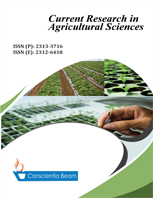Effect of Mid-Term Cropping System Adoption on Soil Chemical Properties at Changunarayan Municipality, Bhaktapur, Nepal
DOI:
https://doi.org/10.18488/journal.68.2021.82.80.89Abstract
Soil chemical properties plays a crucial role in crop yield. In this study, we evaluated the chemical properties of soils under three different cropping systems practiced for more than five years in Changunarayan municipality of Bhaktapur district of Nepal. The cropping systems includes- (i) cultivation inside polyhouse (Treatment A: polyhouse), (ii) paddy-wheat rotation (Treatment B: P-W), and (iii) paddy-wheat-vegetable rotation (Treatment C: P-W-V). Thirty-nine composite samples (13 replicates from each site) were taken from the area based on variation in landforms. Soil pH, organic matter (%), total nitrogen (%), available phosphorus (mgkg-1), and available potassium (mgkg-1) were evaluated for each sample. The study revealed that the soil pH was acidic and ranges between 4.71 and 5.39, organic matter (1.6-2.39%), total nitrogen (0.091-0.13%), phosphorus (4.48-29.24mg kg-1) and potassium (88.04-109.52 mg kg-1). A significant lower mean pH (4.71), and higher mean organic matter (2.39%), total nitrogen (0.13%) and available phosphorus (29.24 mgkg-1) were observed in cultivation under polyhouse. Incorporation of vegetable in paddy-wheat system gave significant (p<0.05) higher accumulation of soil phosphorus and consistently raised other nutrient status. Moreover, cultivation under polyhouse raised C:N ratio (10.55) significantly than other system. This finding can be relevant to wide range of readers that focus on soil chemical properties and can be used in developing future research strategy and sustainable soil management system in the area.

